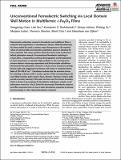Por favor, use este identificador para citar o enlazar a este item:
http://hdl.handle.net/10261/211559COMPARTIR / EXPORTAR:
 SHARE
BASE SHARE
BASE
|
|
| Visualizar otros formatos: MARC | Dublin Core | RDF | ORE | MODS | METS | DIDL | DATACITE | |

| Título: | Unconventional Ferroelectric Switching via Local Domain Wall Motion in Multiferroic ε‐Fe2O3 Films |
Autor: | Guan, Xiangxiang; Yao, Lide; Rushchanskii, Konstantin Z.; Inkinen, Sampo; Yu, Richeng; Ležaić, Marjana; Sánchez Barrera, Florencio CSIC ORCID; Gich, Martí CSIC ORCID; Dijken, Sebastiaan van | Palabras clave: | Ferroelectric switching Multiferroics ε‐Fe 2O 3 |
Fecha de publicación: | abr-2020 | Editor: | Wiley-VCH | Citación: | Advanced Electronic Materials 6(4): 1901134 (2020) | Resumen: | Deterministic polarization reversal in ferroelectric and multiferroic films is critical for their exploitation in nanoelectronic devices. While ferroelectricity has been studied for nearly a century, major discrepancies in the reported values of coercive fields and saturation polarization persist in literature for many materials. This raises questions about the atomic‐scale mechanisms behind polarization reversal. Unconventional ferroelectric switching in ε‐Fe2O3 films, a material that combines ferrimagnetism and ferroelectricity at room temperature, is reported. High‐resolution in situ scanning transmission electron microscopy experiments and first‐principles calculations demonstrate that polarization reversal in ε‐Fe2O3 occurs around pre‐existing domain walls only, triggering local domain wall motion in moderate electric fields of 250–500 kV cm−1. Calculations indicate that the activation barrier for switching at domain walls is nearly a quarter of that corresponding to the most likely transition paths inside ε‐Fe2O3 domains. Moreover, domain walls provide symmetry lowering of the polar structure near the domain boundary, which is shown to be necessary for ferroelectric switching in ε‐Fe2O3. Local polarization reversal in ε‐Fe2O3 limits the macroscopic ferroelectric response and offers important hints on how to tailor ferroelectric properties by domain structure design in other relevant ferroelectric materials. | Versión del editor: | http://dx.doi.org/10.1002/aelm.201901134 | URI: | http://hdl.handle.net/10261/211559 | ISSN: | 2199-160X |
| Aparece en las colecciones: | (ICMAB) Artículos |
Ficheros en este ítem:
| Fichero | Descripción | Tamaño | Formato | |
|---|---|---|---|---|
| Guan_AdvElectrMat_2020_editorial.pdf | 2,11 MB | Adobe PDF |  Visualizar/Abrir |
CORE Recommender
Page view(s)
107
checked on 22-abr-2024
Download(s)
123
checked on 22-abr-2024
Google ScholarTM
Check
Este item está licenciado bajo una Licencia Creative Commons

